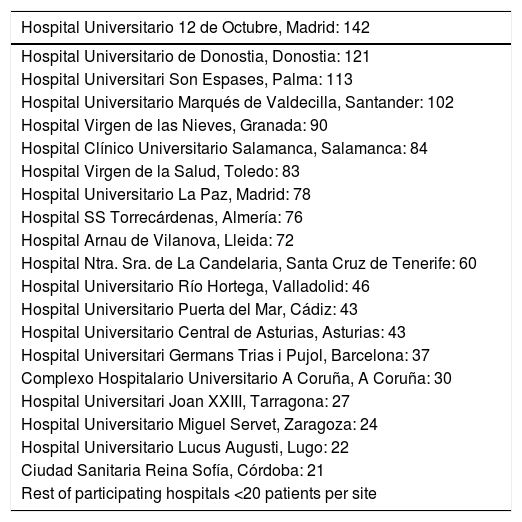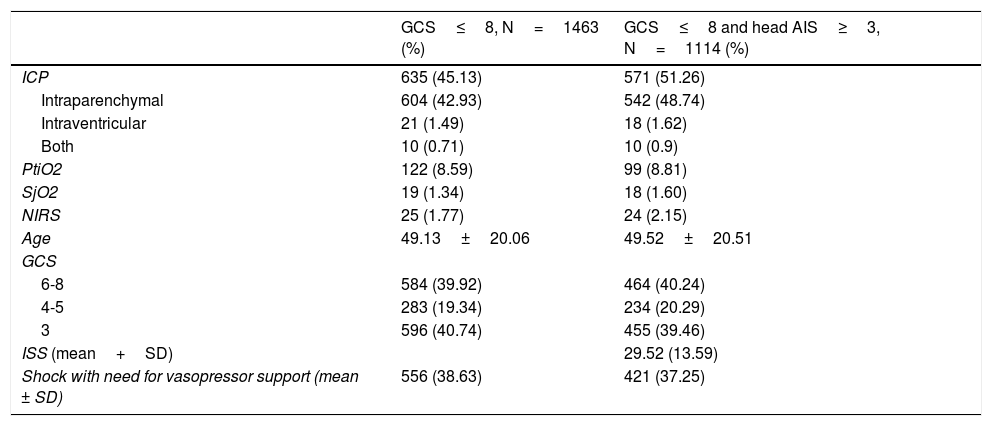To analyze the use of intracranial pressure (ICP) and cerebral oximetry monitoring in patients with severe traumatic brain injury (TBI) according to the Spanish Trauma ICU Registry (RETRAUCI).
MethodsWe included TBI patients with Glasgow Coma Scale score ≤8. Hypotheses were tested using the Student-T or Wilcoxon tests (quantitative variables) and the Chi-square test (categorical variables). Multivariate analysis using logistic regression was performed to analyze the variables associated with the use of ICP monitoring.
ResultsWe analyzed 1463 patients. Age 49.1 years. Males 1130 (77.3%). Mechanism of injury: falls in 350 cases (23.9%). ISS 27.9. Uni- or bilateral mydriasis was present in 39.3% of the patients. Neurosurgical intervention within 24h was performed in 331 patients (22.7%). ICP was monitored in 635 patients (45.1%), pbtO2 in 122 patients (8.6%), SjVO2 in 19 patients (1.34%) and NIRS was used in 25 cases (1.77%). In the multivariate analysis, age, bilateral mydriasis at admission and previous use of antiplatelets or anticoagulants was inversely related with ICP monitoring. Severity of injury and the need of neurosurgical intervention increased the probability of ICP monitoring.
ConclusionsOur study shows a picture of ICP monitoring in severe TBI patients in our environment. Use of cerebral oximetry techniques is very limited.
Analizar el empleo de la monitorización de la presión intracraneal (PIC) y la oxigenación cerebral en los pacientes con traumatismo craneoencefálico (TCE) grave de acuerdo a los datos del Registro español de Trauma en las Unidades de Cuidados Intensivos (RETRAUCI).
MétodosSe incluyeron los pacientes con TCE y una puntuación en la escala de coma de Glasgow ≤ 8 puntos. El contraste de hipótesis se realizó con el test de la t-Student o de Wilcoxon (variables cuantitativas) y el test de Chi-Cuadrado (variables categóricas). Se realizó un análisis multivariante mediante regresión logística para analizar las variables asociadas al empleo de monitorización de la PIC.
ResultadosSe analizaron 1463 pacientes. Edad 49,1 años, hombres 1130 (77,3%). Mecanismo lesional: caídas accidentales 350 casos (23,9%). ISS 27,9. Un 39,3% presentaron midriasis uni- o bilateral en la recogida. Cirugía craneal <24horas 331 pacientes (22,7%). La PIC se monitorizó en 635 pacientes (45,1%), la ptiO2 en 122 pacientes (8,6%), la SjO2 en 19 pacientes (1,34%) y se empleó el NIRS en 25 casos (1,77%). Tras el análisis multivariante, la edad, la midriasis bilateral al ingreso y la toma previa antiagregantes o anticoagulantes se asociaron negativamente con la probabilidad de monitorización de la PIC. La gravedad lesional y la necesidad de neurocirugía urgente aumentaron la probabilidad de monitorización.
ConclusionesNuestro trabajo muestra una foto fija de la monitorización de la PIC en el TCE grave en nuestro medio. El empleo de técnicas de oximetría cerebral en nuestro país es muy limitado.
Article

If it is the first time you have accessed you can obtain your credentials by contacting Elsevier Spain in suscripciones@elsevier.com or by calling our Customer Service at902 88 87 40 if you are calling from Spain or at +34 932 418 800 (from 9 to 18h., GMT + 1) if you are calling outside of Spain.
If you already have your login data, please click here .
If you have forgotten your password you can you can recover it by clicking here and selecting the option ¿I have forgotten my password¿.








